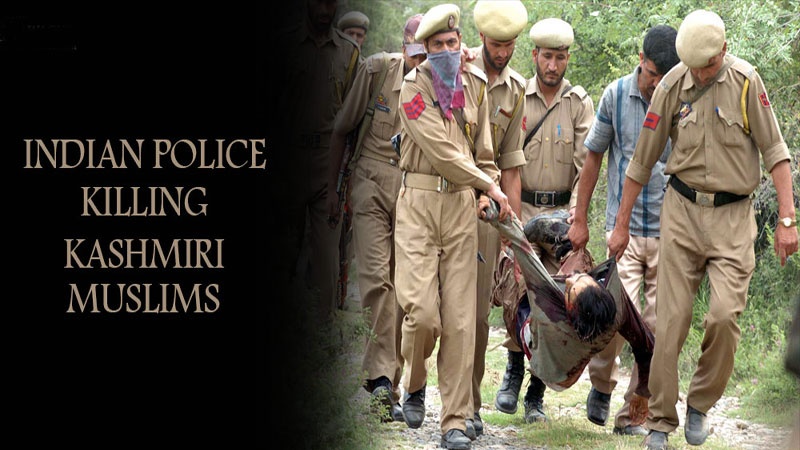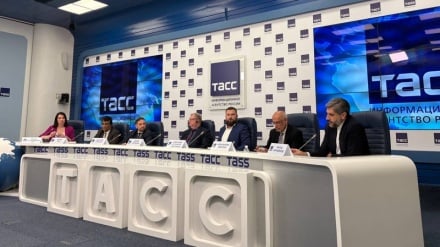Kashmiri people being killed amid global silence
The current turmoil in Indian-controlled Kashmir that is taking a heavy toll of Muslim life as a result of the trigger-happy attitude of Indian forces, coupled with the intransigence of the government in New Delhi.
It refuses to hold the UN-directed plebiscite to determine the status of the picturesque Himalayan land, whose fate the British colonialists deliberately left in limbo in 1947 against the aspirations of the local people while partitioning the subcontinent, is against stoking tensions with Pakistan, arousing fears of the three wars the two neighbours have fought over this predominantly Muslim-populated region. Following is an analysis on this chronic question.
Kashmir is a region located in northwest of the Indian Subcontinent. It is comprised of Indian-administered Jammu and Kashmir State, Pakistani-administered Azad Kashmir; the Gilgit-Baltistan state under Islamabad’s control; as well as and the Chinese-administered Aksai Chin. The region is mostly mountainous, and the Qaraqoram mountain range contains K2 Summit, the second-highest mountain on the earth and several other very high mountain peaks. Kashmir is also considered as one of key areas of influence of the Persian language, as Iqbal Lahori, the prominent poet-philosopher of the Subcontinent called it “Iran-e Sagheer” or “Smaller Iran.” The region was later recognized by this name and the people in the region now often use this name for Kashmir, where Islam entered a millennium ago, and which in the fourteenth century became predominantly Muslim, thanks to the enlightening efforts of the Iranian Gnostic, Mir Seyyed Ali Hamadani. The region from north and east meets China, from south meets India, from west shares borders with Pakistan, and from northwest shares borders with Afghanistan. The Indian state of Jammu and Kashmir is a 101,437 square kilometers area, and it has a population of over 12 million, according to a 2011 official census. Srinagar is the summer capital of the Indian state of Jammu and Kashmir. Its winter capital is Jammu. A large part of the region including Kashmir Valley and Jammu and Ladakh are controlled by India. China, on the other side, holds the mostly unpopulated regions which cover a 42,685 square kilometers area. The Pakistan-administered Kashmir contains Azad Kashmir with Muzaffarabad as its capital in an area of 5,619 square kilometers and Gilgit-Baltistan state with an area of 72,496 square kilometers.
Kashmir, which for centuries had been ruled by successive Muslim dynasties, before independence of the subcontinent in 1947 was ruled by a British-installed Hindu Rajah. On partition of the subcontinent both Pakistan and India argued that it was their right to rule over Kashmir. Three wars were fought in 1948, 1965 and 1971. According to the figures of 1947, of the then 5.5 million population of Kashmir Valley 95 percent were Muslims and only four percent of them were Hindus. Of the four million population of Jammu 30 percent were Muslims, 66 percent were Hindus, and four percent are from other religions. In Ladakh, of the 280,000 people 46 percent were Muslims, 50 percent Buddhist, and three percent are from other faiths. Furthermore, in Azad Kashmir, there were 300,000 people in 1947 and all of them Muslims. In northern areas of Pakistan-controlled Kashmir 1 million people were living, and 99 percent of them were Muslims.
The eruption of the recent Kashmir clashes in Kashmir are the result of the mistrust of the local Muslim people against the government in New Delhi, which they complain has adopted a step-motherly attitude towards them, and refuses to respect their aspirations for deciding the fate of their homeland as per the UN directive for referendum. Most of the Kashmiris want to be independent of India, while some prefer merger with Pakistan.
Since Friday July 15, up to now the clashes in Indian-administered Kashmir continued. Nearly 3,000 people have been reported injured and over 50 were killed. The Indian media have reported of ongoing clashes in Kashmir despite the heavy security crackdowns imposed by the government. The clashes witnessed a rise after Burhan Wani, whom the government said to be a militant, was killed by the Indian forces. NDTV reported that since Friday and after resumption of clashes and violent demonstrations in Kashmir at least 50 people were killed and over 2,000 people were injured. The media reports suggest that during one of the rallies, the protesters smashed a police station in Kupwara District in northern Kashmir. In response, the security forces opened fire at them, killing a number of them. In other parts of Kashmir the demonstrations went violent after police clashed with the demonstrators and used batons to put down the protests. The journalists and editors-in-chief of media in Srinagar also protested the city officials’ decision to block release of any newspapers in the city. The security forces have attacked the journalists and detained some of them, according to the reports.
During the past two weeks and after killing a separatist group's leader in fighting with Indian forces, heavy clashes broke out in Kashmir, so far claiming lives of scores of protesters, and pushing the Indian authorities to declare curfew in the region. Top separatist leaders including Syed Ali Geelani, Mir Waiz Farouqi, Sardar Mohammad Yasin Malik, Shabir Ahmed Shah, and others were put under house arrest or detained as they took part in the anti-government demonstrations. In India’s Jammu and Kashmir State— or Indian-administered Kashmir as some media put it — people several times took to the streets, demanding self-administration and independence from India. The recent waves of demonstrations sparked after killing of a couple of young leaders of militant groups by the Indian security forces. As people took to the streets for protesting, the Indian security forces have imposed curfew to put down the demonstrations, so far killing over 50 people and injuring 3000 others. The curfew has been lifted and re-imposed, and is said to be standing still yet, after conditions failed to return to normal.
Meanwhile, Syed Ali Geelani, the most prominent separatist leader in Jammu and Kashmir for the first time sent letters to Iran and China, calling for their support and mediation for settling the increasingly critical conditions in Kashmir. Geelani also wrote to the members of UN Security Council and the regional organizations like EU, Association of Southeast Asian Nations, Islamic Cooperation Organization, and South Asian Association for Regional Cooperation, calling on them to convince India to make assurances, accept the nature of Jammu and Kashmir crisis, revoke the Indian Armed Forces Special Powers Law, and start process to withdraw military forces of the country from the crisis-hit state. Geelani believes that the addressed countries and organizations are responsible for trying to stop the Indian horror created by New Delhi in Jammu and Kashmir, and should prioritize demanding for release of political prisoners and asking for paving the way for free political activity in India. The BJP government in New Delhi
The fact is that border clashes, as well as religious and political rifts, especially over Kashmir, have been existing between India and Pakistan since the partition of the Subcontinent. The existence of radical and terrorist groups in Pakistan’s territories and their negative effects on South Asia's security situation caused New Delhi to point fingers at Islamabad after any terrorist attack in India. To put strains on Pakistan, India always accused Islamabad of backing the Taliban and other violent groups in India and Jammu and Ladakh states. As a result, over the past 70 years the tensions between the two sides have failed to stop. On the other side, in northern side of Kashmir, India has border struggles with China. Perhaps one of the reasons foiling any solution to the chronic issue of Kashmir is India’s turning blind eyes to the rights of the Kashmiri people. In fact, each of the players involved in Kashmir looks at the issue from its own perspective— an issue keeping the international players from getting involved in the struggle for settlement.
India considers the Kashmir conflict as a domestic issue, while Pakistan uses it to press New Delhi. This issue has deprived the world from hearing the right news and information from Kashmir. On the other hand, due to regional crises, the international media give a very little coverage to the events in Kashmir. For example, the recent Kashmir clashes started before the coup attempt in Turkey but the news, even in the Iranian media, failed to be covered adequately. Meanwhile, the West, led by the US, in view of the rifts between India and Pakistan as well as between India and China, has declined to show any care and concern for the plight of the Kashmiri Muslims, and in this way seeks continuation of this crisis in South Asia.
While some argue that due to sensitiveness of the issue, and Iran’s good relations with both India and Pakistan, Tehran has not paid much attention to the crisis in Kashmir, others claim that Kashmir is the strategic depth of the Islamic Revolution and its connection to Central Asia. Still others are of the opinion that because of the infiltration of Takfiri terrorist outfits with ties to the Wahhabi regime of Saudi Arabia, the Islamic Republic of Iran is cautious of the players involved in Kashmir. Nonetheless, Kashmir’s geopolitical position straddling the borders of India, Pakistan, and China, as well as its proximity to the two Persian speaking countries of Afghanistan and Tajikistan, means the deep impact of Iranian culture and the Islamic Revolution amongst the Kashmiri Muslims, have made the region of strategic significance for Tehran. The people there still like to call the region Iran-e Sagheer or Smaller Iran, as eulogized by the poet-philosopher of the Allamah Dr. Iqbal Lahori.
Last year, Hakim Sajjad Hussein Rouhani, a prominent Kashmiri political activist, in a conference in Iran's northeastern Mashhad province said that “Iran and Kashmir share cultural commonalities so much that people there call Kashmir smaller Iran.” Furthermore, referring to the influences of the Islamic Revolution on the Muslim states, he said that during the 8-year imposed on Iran in the 1980s by the US through Saddam of the repressive Ba’th minority regime of Baghdad, the Kashmiri people, especially the Shi’ite Muslims, like their counterparts throughout India and Pakistan, showed solidarity with the Islamic Republic of Iran. In view of these facts, the Kashmiri activist hoped for a firm stance by Tehran on the killing of the Muslims of Kashmir. He said that taking advantage of the silence of the global community and international organizations, the Indian government has violently quelled the Muslims in Kashmir, which he added is part of the Muslim World, despite its geographical location in the Subcontinent.
For the solution of Kashmir problem nothing has been done apart from simply maintaining the status quo and providing facilities to the people on both side of the India-Pakistan border for travel and trade. Strict monitoring of such basic facilities of travel and trade reduced it to be a worthlessness claim. The irony is that whenever the situation in Kashmir moves towards peace, Indian and Pakistani leadership falls into slumber believing everything has become normal only to be woken up by the crisis like that of 2008 and 2010. And even then after displaying temporary panic and confusion they go back to sleep again, and that is the cause of the present crisis. It could have been much pleasant and welcome if selected members of the civil society approached the leaders of both countries and the media and tell them, ‘For God’s sake stop cooking your meals on the fire burning in Kashmir so that some fruitful political activity may be started.’ Despite the dangerous and unpredictable situation the Kashmiris have not yet lost their patience and have not said good bye to their self-restrain. Several attempts have been made to pave the way to create sectarian hatred by having the Amarnath Hindu pilgrims attacked. Last week when Gujarati pilgrims found themselves forced to take refuge at Nageen Club, the local Muslims looked after them with great respect and dignity. When more than 60 elderly, youths and women reached Delhi they had lavish praise for Kashmiris. Similarly the manner in which local Muslims braved the curfew restrictions only to rescue the Hindu pilgrims and non-pilgrims who had met an accident in South Kashmir in Bijbehara. There are lessons to be learnt here by the partisan media and political opportunists who are leaving no stone unturned and crossing all the limits in character assassination of the Kashmiris.
All said and done, the situation in Kashmir is going from bad to worse, because of the high-handed approach of the ruling party in New Delhi. If the situation is not improved down, and talks do not begin earnest between India and Pakistan, with of course, the representatives of the Kashmiri people present, Kashmir could easily become a humanitarian crisis on a gigantic scale. India’s former interior minister, P. Chidambaram has boldly spoken the unspeakable about Kashmir. He is the first ranking member of any of the political parties to say openly that India has reneged on the bargain the Kashmiris were promised. Immediately, the government and the sections of the media advocating the repression of the Kashmiri people at any cost, called him anti-national. It is unfortunate that the entire issue of popular consultation was forgotten. Article 370 remained in the Indian Constitution but the state lost its autonomy as defined therein. The mantra became Kashmir is an integral part of India. The Congress failed in the 50 years after Independence to win over the minds and hearts of the people of Kashmir, and now the present government is making the situation even worse, as was evident by the army’s brutal killing of 22-year old Burhan Wani, who posed no danger. According to analysts, a dozen boys with a few guns — they were no threat to the Indian army, one of the largest in the world. There is no record of Burhan and his crew waging any attack. Their rebellion was symbolic, a war of images against India’s continuing occupation of Kashmir, where about half a million of Indian soldiers, paramilitary and armed police are still stationed. But, whatever the strength of the Indian army, already one line of graffiti had appeared on every other wall throughout the entire valley: “Go India, Go Back!”
AS/ME



